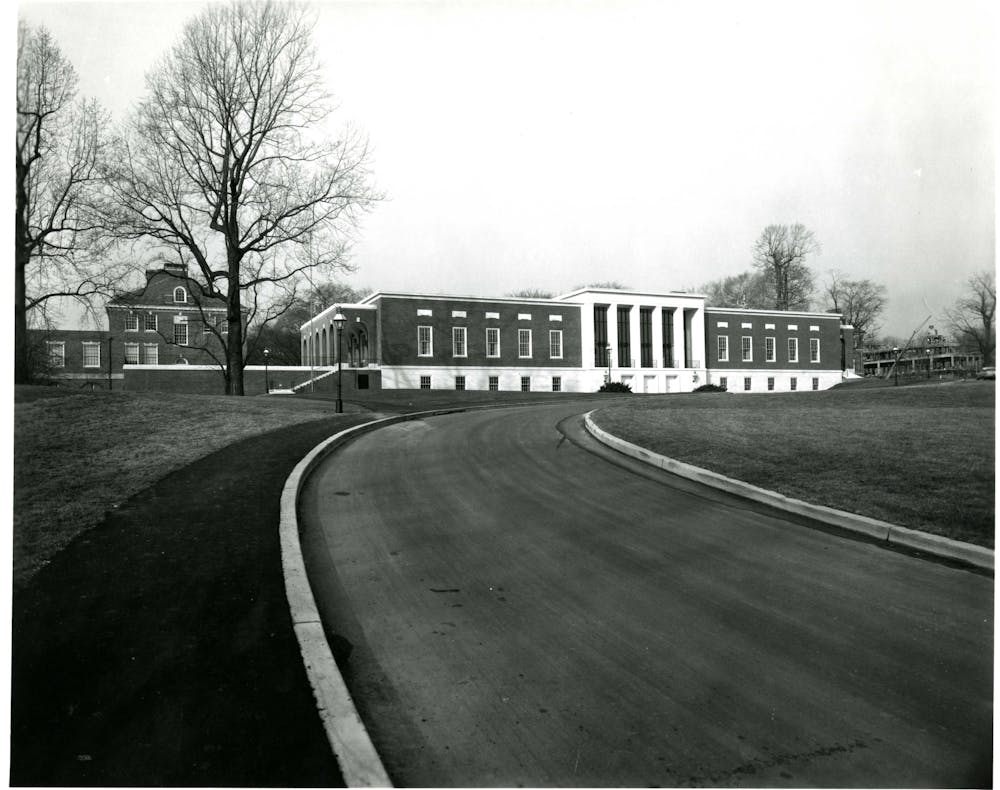The Milton S. Eisenhower Library (MSE), a staple of the Homewood Campus, has a rich and complex history. During the 1940s, the University faced a lack of space as Gilman Hall and other buildings on campus could not accommodate the growing number of texts in their archives. In 1947, former librarian Homer Halvorson noted that Hopkins would need to begin planning a new facility.
However, construction took several decades to begin. It wasn’t until 1958 that the University began a 10-year, $76 million funding drive, according to the Baltimore News-Post. Specifically, a new library was listed as one of the primary needs for the campus. Later that year, it was decided that the new library would be built at the front of Keyser Quad, and preliminary construction began in June 1962.
The architecture of the library followed the Georgian motifs of nearby buildings, with red brick and white trim. Former librarian John Berthel stated that the new building would hold over 1.5 million volumes, with a maximum capacity of over 4 million.
Milton S. Eisenhower, the University’s president from 1956 to 1967, emphasized the need for a new library at a research institution such as Hopkins, especially considering the overflowing archives during the 1950s.
“In a university like Johns Hopkins, where research permeates the educational program of all undergraduates, graduate and post-doctoral students, and where every member of the faculty is engaged in research, the library is the very heart of the institution,” Eisenhower said in an interview with The News-Letter in 1962. “We have outgrown the library facilities of Gilman Hall, and we need to have the new research library in operation just as soon as possible.”
Ultimately, Hopkins raised over $4.5 million for the library, all of which was accumulated through the drive from 1958 to 1962, as stated by The Sun in an article from 1964. The drive, headed by the Board of Trustees Chairman Eli Frank Jr., collected donations from alumni and community members over four years to fund the library and other University initiatives. This included $2.5 million from one patron, alum R. Champlain Sheridan.
From the outside, the MSE Library looks deceptively one-storied. However, it is a six-level structure with five levels being underground. Originally, the University wanted to use concrete to build the library, but it soon proved unfeasible to construct the building so deep underground with concrete. Two months before construction began, though, V50 steel was introduced to the market. This steel was high-strength and proved more cost-effective than conventional steel.
As stated by the University’s Office of Public Relations in a press statement in 1962, construction was only economically feasible thanks to this newly introduced V50 steel supplied by the Bethlehem Steel Corporation. Thanks to their strength, the steel beams did not have to be dug as deep into the ground, which kept the building within its height limitations.
In addition to the new steel technology, the library also boasted several cutting-edge innovations. In an article from 1962 entitled “Library With Built-In Future,” journalist John Schmidt listed the library’s technological advancements, which included a computer lab available to students, 20 microfilm readers with controllable brightness and photo duplication facilities.

COURTESY OF NICK DAUM
The library was constructed mainly to house humanities and social science materials and artifacts. According to original building plans, humanities and social science stacks would take up M, A, B and D levels, while only C level was set aside for science and engineering references and stacks. The surface level, meanwhile, housed the administrative office and entrance.
Construction of MSE ended after two years, and an opening ceremony was held on Nov. 7, 1964. The library was called a “citadel of knowledge” by The Sun, and Eisenhower dedicated the library to “Dreams of Scholarship.”
“Johns Hopkins simply could not exist without its library. It is our citadel of knowledge, the physical and spiritual heart of the university,” wrote The Sun. “In the university's library the problems of multiplicity growing out of the ‘knowledge explosion’ take on an awesome physical reality.”
The library was quickly integrated into the University campus. Over a million books were brought from Gilman Hall to the MSE Library in 1964, and more were added in subsequent years. Additionally, the library hosted an art collection — including two Pablo Picasso pieces and one Rembrandt piece — from Nov. 9 to Nov. 15 that year.
Since its construction, MSE has undergone several renovations and expansions. In 1991, the library used a new gas technique to deacidify old books, ensuring that they could be preserved for hundreds of years more, according to The Evening Sun.
In 2003, the University expanded the library with the construction of Brody Learning Commons, a 50,000-square-foot addition. The Baltimore Sun wrote that this expansion would be a free-standing building connected to MSE underground and include a large quiet reading room, group study rooms, a cafe and several seminar rooms and classrooms.
More recently, the library has hosted several special events. This included a rare book collection in 2011, which included a first edition of Galileo Galilei’s illustrated treatise on the discovery of sunspots and Isaac Newton’s treatise on “Gravitation Principia.”
Today, the library stands as a fixture of the Homewood Campus across from Gilman Hall on Keyser Quad. While MSE is not undergoing construction currently, the University plans to begin renovation in summer 2024, which will be the first fully shutdown reconstruction since 1964. For now, students occupy all six levels of the building — learning, studying and researching in this “citadel of knowledge.”

















